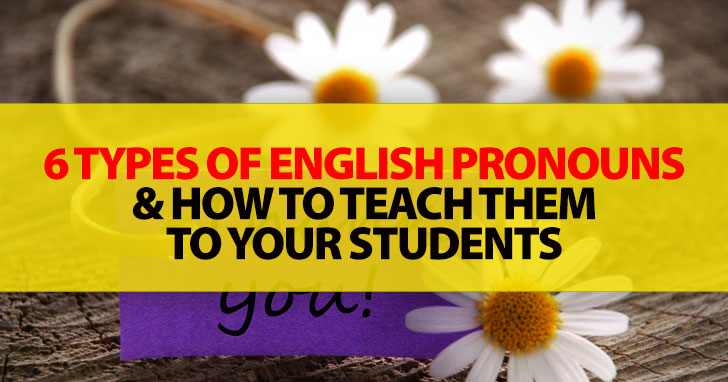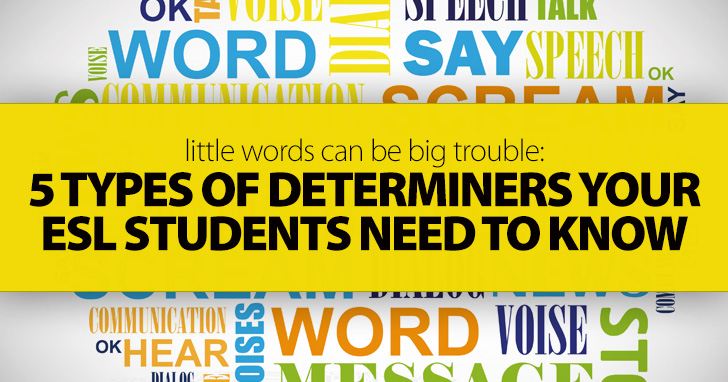6 Types Of Pronouns And How To Teach Them To Your Students


Besides the comfortable companionship of adjectives, nouns tend to keep certain words close to them. These words, which you and your students know as articles, determiners, and quantifiers, help the reader or listener know which of a multitude of nouns the speaker is referring to. The question is, how does a person use them? And how does someone teach their ESL students how to use them correctly? While many ESL students will have little to no trouble with these often tiny words, some students have native languages which do not use articles or use a completely different system for choosing articles.
What follows is a breakdown of these noun companions and how to teach them to your students.They may find that these little English words are a whole lot of trouble.
Determiners are a class of words in the English language that point out which of a particular noun a speaker is referring to. They are not a part of speech but are actually a linguistic category of words. Determiners can be used to refer to a specific noun or a general noun. In some ways, they are like adjectives, giving additional information about the noun with which they are paired, but there are a limited number of determiners in the English language. And while not every noun has a determiner, a noun never has more than one determiner. There are several classes of English words which fall under the category of determiner: articles, numbers, indefinite pronouns, demonstrative pronouns, and possessive pronouns. Read on to learn more about each of these parts of speech.
English has three articles – the, a, and an. These simple little words tell the listener what particular noun a speaker is referring to. The refers to a specific noun. It refers to the only one of that particular noun in existence (the Sears Tower), or it may refer to a specific noun that was mentioned earlier in the sentence or conversation. (I bought a book. The book is on the table.) A, on the other hand, is a general article. When used with a noun, it refers to any of that particular noun in existence. (He ate a pear.) It is not referring to one specific noun nor is its unique identity important. An works the same way as a with one difference. English speakers use a before nouns which begin with consonant sound, an before words which begin with vowel sounds (a book, a ride, an apple, an egg). Note that it is not spelling which determines whether to use a or an but the initial sound (a university, an hour). Some is sometimes referred to as an article though technically it is an indefinite pronoun. Some teachers choose to tell their students that some is the plural form of a or an since the latter are only used with singular nouns. The can be used with either singular or plural nouns.

Numbers are one of the first things an ESL student studies. In fact, learning to count in some foreign language is something almost anyone can do. But counting and using numbers as determiners are not exactly the same thing. When a number is used as a determiner, it comes before the noun and specifies the specific number of that noun to which the speaker is referring. Sam had two books, six pencils, and four assignments.
Indefinite pronouns are those which do not refer to a specific noun. In that way, they are similar to the word a, but they give more information than it does. Indefinite pronouns include anyone, anywhere, somewhere, someone, more, several, few, many, both, all, and any. Anyone and someone refer to a nonspecific person. Anywhere and somewhere refer to a nonspecific person. More is used to mean in addition (I want more cake). Few, several, and many refer to a general amount of a given noun (He as read several books). Both and all refer to all of an item, whether the number is unspecified or the number is two (as in the case with both). In most cases, an indefinite pronoun can be replaced with a, an, or some in a sentence without affecting the grammar of the sentence, but it will slightly affect the meaning of the sentence.
English has four demonstrative pronouns: this, that, these, and those. They are used to refer to specific nouns that are either singular or plural and are relatively near the speaker. This refers to a singular noun near the speaker. These refers to a plural noun near the speaker. That refers to a singular noun that is farther away from the speaker. Those refers to a plural noun that is farther away from the speaker. There is no hard and fast rule whether to use this or that, these or those. The specific distance does not determine the word choice. It is the general impression of the speaker which determines which word is the best choice in given circumstances.
A possessive pronoun is used to show possession of a noun. English has a finite set of possessive pronouns: my, your, his, her, its, our, and their. These pronouns agree in number with the noun showing ownership.
Quantifiers are worth a mention here though they are NOT determiners. Quantifiers are used with a noncount noun to make that item countable. They do not fill the role of a determiner. They are actually nouns and are preceded by their own determiners.
In the previous sentence, bucket is the noun and a is the determiner (article). Water is also a noun, but in this sentence it is the object of the preposition. It does not have a determiner though it is possible for a noncount noun in a prepositional phrase to also have a determiner as in the following sentence.
Though there are many types of determiners in English, each noun we find will only use one of them. Often, it is best to introduce one type of determiner to your students at a time. As you do, be sure to point out to your students that they are members of the linguistic category or class of determiners and are not a part of speech though several parts of speech belong to the class of determiners.